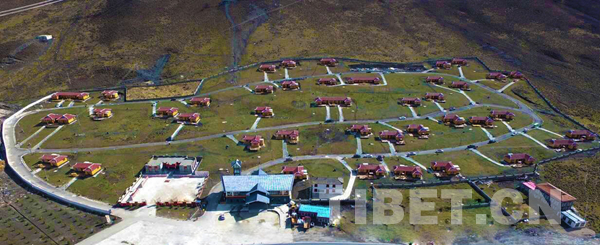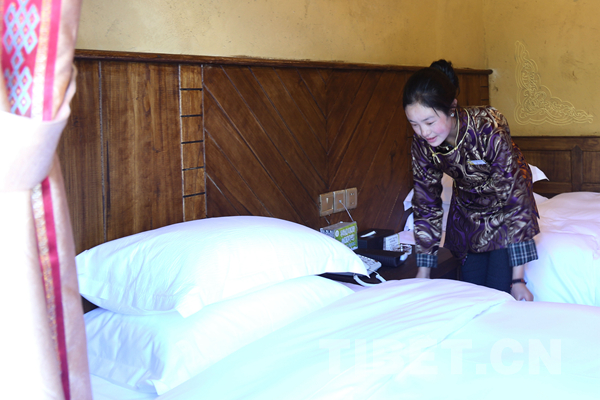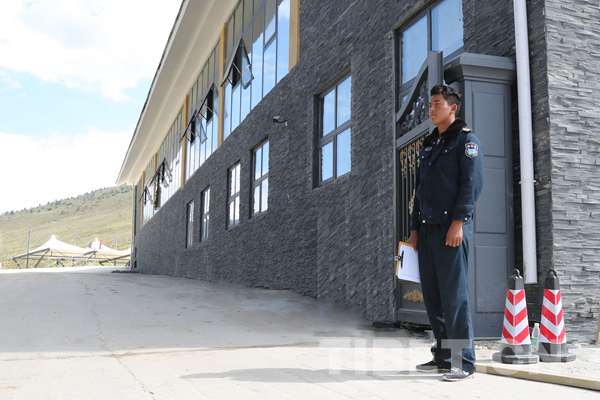Eda Menpa's major shift (IV): Nomadic Areas Now Tourist Attractions
Editor's note: The Sichuan-Tibet Plateau, a beautiful region that reaches toward the heavens, is a place showered with blue skies, covered in white clouds, and dotted with snow-covered mountains, but recently, something truly remarkable has been materializing among the households that call this place home. A groundbreaking historic change has been reshaping the land and its people. From today on, we will publish a series of stories to tell you those changes.
"I can't really grasp how one year has completely transformed our hometown into such a modern tourist destination," says Tenzin, a former villager turned tour guide, "and now they just pour in!"
From June 2015 to April 2017, 150 million yuan have been invested toward developing the attraction and building various facilities catered to incoming tourists, such as a 16.5-kilometer-long (10.25-mile-long) road, a 3,600-square-meter (38,750-square-foot) reception office and observation platform, a venue for horse racing, a Muya-culture exhibition square displaying a statue of King Songtsen Gampo’s marriage to Muya Princess Jamtson, a traditional Muya street, Jamtson Hotel, and many other structures.
The local government and enterprises are always in negotiations, and all designs and projects related to the tourist attraction must maintain the principle of using original traditional products and supplying the livelihoods of the local Tibetan people. This means that grasslands, yaks, and houses must all be preserved in the traditional local fashion, and the herders should never be disrupted while construction is underway and especially never asked to move out of the area. This ensures that the benefits of the original customs and ways of life are perfectly maintained while still drawing the population out of its dire situation.
Tardo City has also been active in its support of Eda Menpa's newfound popularity among tourists, and it has allocated certain funds it receives from various channels, such as comfortable-housing projects and poverty-relief entities, to the village’s overall plan. Some funds are used to build new houses for impoverished families, with these households encouraged to develop animal husbandry, and some funds are used to upgrade electrical systems, provide better access to drinking water, and construct new roads. 40-some-odd households have seen their problems with electricity and sanitary water disappear through this initiative, and telecommunication and broadband networks have been locally installed. To make the No. 318 the best national road throughout all of China, a station providing comprehensive services, such as 14 separate water dispensers, dining facilities, places just to sit and relax, and a shop selling local products, has also been set up nearby. This is all not to mention the fact that trees and flowers are being planted as part of an ecological strategy, with plans of preserving wetlands along the side of the highway currently under consideration.
Now, with the passing of each and every day, one plan is being completed after another. Once poor villagers have become wealthy, and many have found that they have been holding a "golden rice bowl" all this time. In Tardo and other areas of China that Tibetans call home, the state-issued policy guidelines concerning poverty relief have been a success, and more and more herders and farmers are flocking to the new and improved society that most certainly awaits them if they work hard enough for it.
The Chinese version of this story is written by Zhuhong & Zhouyu and translated into English by Huang Wenjuan. And the story is sourced from the United Front Work Deparment of the Communist Party of China (CPC)Sichuan Provincial Committee.
Your Comment
Name E-mailRelated News
-
;
-
-
-
Eda Menpa's major shift (III): Resources Now Seen as Assets
Just as rivers and valleys can quickly turn into grassland when travelling, the village’s nomadic life has shifted to something completely foreign and new.
-
-
-
-
Eda Menpa's major shift (II): From Herders to Shareholders
To be better off as a society, locals had to look for a hand up to get out of their critical situation and eventually adopted initiatives presented through targeted poverty-relief projects.
-
-
-

-
A tapestry of achievement: Eda Menpa's major shift (I)
From a poor village to a tourist hub and from being impoverished to becoming shareholders, how is it that Eda Menpa and its people have attained such great success?
-
Based in Lhasa, Tibet Vista is a Tibet travel agency that specialized in Tibet permit, and Tibet tours for both private and group travelers at a local price!
•4 Days Lhasa City Group Tour from USD 460 •8 Days Everest Base Camp Group Tour from USD 850 •15 Days Mt.Kailash Group Tour from USD 1780 •2016 Tibet Train Tours from Beijing, Shanghai, Chengdu, Xining,etc












